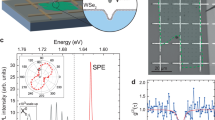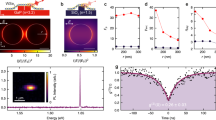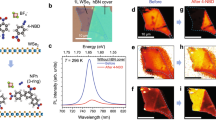Abstract
Achieving unity quantum efficiency in single-photon emitters (SPEs) is a holy grail in quantum information science. Through plasmonic coupling it is possible to increase the quantum efficiency of SPEs by increasing the radiative decay rate, but to approach unity quantum efficiency, non-radiative decay must be mitigated. Here we show that non-radiative decay in two-dimensional WSe2 quantum emitters can be electrically suppressed through charge depletion by using dual gate configurations under a large electric field. In this condition, for site-controlled SPEs in WSe2 coupled to gold nanogaps, the SPE transition quantum efficiency after gating is increased to 76.4 ± 14.6% on average, with some SPEs reaching near-unity (more than 90%) quantum efficiency. This study provides a new approach for tuning SPEs with an applied gate voltage and motivates further theoretical and experimental studies of SPE enhancement on vertically aligned nanogaps.
This is a preview of subscription content, access via your institution
Access options
Access Nature and 54 other Nature Portfolio journals
Get Nature+, our best-value online-access subscription
$32.99 / 30 days
cancel any time
Subscribe to this journal
Receive 12 print issues and online access
$259.00 per year
only $21.58 per issue
Buy this article
- Purchase on SpringerLink
- Instant access to full article PDF
Prices may be subject to local taxes which are calculated during checkout




Similar content being viewed by others
Data availability
The data that support the findings of this study are available from the corresponding author upon reasonable request. Source data are provided with this paper.
References
Aharonovich, I., Englund, D. & Toth, M. Solid-state single-photon emitters. Nat. Photon. 10, 631–641 (2016).
Chakraborty, C., Kinnischtzke, L., Goodfellow, K. M., Beams, R. & Vamivakas, A. N. Voltage-controlled quantum light from an atomically thin semiconductor. Nat. Nanotechnol. 10, 507–511 (2015).
Tonndorf, P. et al. Single-photon emission from localized excitons in an atomically thin semiconductor. Optica 2, 347–352 (2015).
Koperski, M. et al. Single photon emitters in exfoliated WSe2 structures. Nat. Nanotechnol. 10, 503–506 (2015).
Srivastava, A. et al. Optically active quantum dots in monolayer WSe2. Nat. Nanotechnol. 10, 491–496 (2015).
He, Y.-M. et al. Single quantum emitters in monolayer semiconductors. Nat. Nanotechnol. 10, 497–502 (2015).
Parto, K., Azzam, S. I., Banerjee, K. & Moody, G. Defect and strain engineering of monolayer WSe2 enables site-controlled single-photon emission up to 150 K. Nat. Commun. 12, 3585 (2021).
Palacios-Berraquero, C. et al. Large-scale quantum-emitter arrays in atomically thin semiconductors. Nat. Commun. 8, 15093 (2017).
Branny, A., Kumar, S., Proux, R. & Gerardot, B. D. Deterministic strain-induced arrays of quantum emitters in a two-dimensional semiconductor. Nat. Commun. 8, 15053 (2017).
Kern, J. et al. Nanoscale positioning of single-photon emitters in atomically thin WSe2. Adv. Mater. 28, 7101–7105 (2016).
Shepard, G. D. et al. Nanobubble induced formation of quantum emitters in monolayer semiconductors. 2D Mater. 4, 021019 (2017).
Kumar, S., Kaczmarczyk, A. & Gerardot, B. D. Strain-induced spatial and spectral isolation of quantum emitters in mono- and bilayer WSe2. Nano Lett. 15, 7567–7573 (2015).
Cai, T. et al. Radiative enhancement of single quantum emitters in WSe2 monolayers using site-controlled metallic nanopillars. ACS Photon. 5, 3466–3471 (2018).
Luo, Y. et al. Deterministic coupling of site-controlled quantum emitters in monolayer WSe2 to plasmonic nanocavities. Nat. Nanotechnol. 13, 1137–1142 (2018).
Iff, O. et al. Deterministic coupling of quantum emitters in WSe2 monolayers to plasmonic nanocavities. Opt. Express 26, 25944–25951 (2018).
Zhang, Y. et al. Simultaneous surface-enhanced resonant raman and fluorescence spectroscopy of monolayer MoSe2: determination of ultrafast decay rates in nanometer dimension. Nano Lett. 19, 6284–6291 (2019).
Dutta, S. et al. Coupling quantum emitters in WSe2 monolayers to a metal-insulator-metal waveguide. Appl. Phys. Lett. 113, 191105 (2018).
Blauth, M. et al. Coupling single photons from discrete quantum emitters in WSe2 to lithographically defined plasmonic slot waveguides. Nano Lett. 18, 6812–6819 (2018).
Li, C. et al. Arbitrarily structured quantum emission with a multifunctional metalens. eLight 3, 19 (2023).
Lien, D.-H. et al. Electrical suppression of all nonradiative recombination pathways in monolayer semiconductors. Science 364, 468–471 (2019).
Li, M., Biswas, S., Hail, C. U. & Atwater, H. A. Refractive index modulation in monolayer molybdenum diselenide. Nano Lett. 21, 7602–7608 (2021).
Chen, P. et al. Approaching the intrinsic exciton physics limit in two-dimensional semiconductor diodes. Nature 599, 404–410 (2021).
Hötger, A. et al. Gate-switchable arrays of quantum light emitters in contacted monolayer MoS2 van der Waals heterodevices. Nano Lett. 21, 1040–1046 (2021).
Anderson, C. P. et al. Electrical and optical control of single spins integrated in scalable semiconductor devices. Science 366, 1225–1230 (2019).
Doi, Y. et al. Deterministic electrical charge-state initialization of single nitrogen-vacancy center in diamond. Phys. Rev. X 4, 011057 (2014).
Wang, Z. et al. Selectively plasmon-enhanced second-harmonic generation from monolayer tungsten diselenide on flexible substrates. ACS Nano 12, 1859–1867 (2018).
Wang, Z. et al. Giant photoluminescence enhancement in tungsten-diselenide–gold plasmonic hybrid structures. Nat. Commun. 7, 11283 (2016).
Cai, H. et al. High-throughput fabrication of ultradense annular nanogap arrays for plasmon-enhanced spectroscopy. ACS Appl. Mater. Interfaces 10, 20189–20195 (2018).
Fuchs, F. et al. Engineering near-infrared single-photon emitters with optically active spins in ultrapure silicon carbide. Nat. Commun. 6, 7578 (2015).
Wang, J. et al. Bright room temperature single photon source at telecom range in cubic silicon carbide. Nat. Commun. 9, 4106 (2018).
Scavuzzo, A. et al. Electrically tunable quantum emitters in an ultrathin graphene–hexagonal boron nitride van der Waals heterostructure. Appl. Phys. Lett. 114, 062104 (2019).
Fisher, B. R., Eisler, H.-J., Stott, N. E. & Bawendi, M. G. Emission intensity dependence and single-exponential behavior in single colloidal quantum dot fluorescence lifetimes. J. Phys. Chem. B 108, 143–148 (2004).
Schlegel, G., Bohnenberger, J., Potapova, I. & Mews, A. Fluorescence decay time of single semiconductor nanocrystals. Phys. Rev. Lett. 88, 137401 (2002).
Sun, D. et al. Observation of rapid exciton–exciton annihilation in monolayer molybdenum disulfide. Nano Lett. 14, 5625–5629 (2014).
Chen, Y. et al. Rapid focused ion beam milling based fabrication of plasmonic nanoparticles and assemblies via ‘sketch and peel’ strategy. ACS Nano 10, 11228–11236 (2016).
Acknowledgements
We thank I. Yudhistira, A. Ling and J. Aizpurua for useful discussions. This work is supported by the Singapore National Research Foundation through the QEP programme (grant numbers NRF2021-QEP2-01-P01, NRF2021-QEP2-01-P02, NRF2021-QEP2-03-P01, NRF2021-QEP2-03-P10 and NRF2022-QEP2-02-P13) and the Singapore Ministry of Education (grant number MOE-T2EP50222-0018). W.G. and Z.D. acknowledge funding from an A*STAR MTC IRG grant (project number M21K2c0116). C.-W.Q. acknowledges support from the National Research Foundation (grant number NRF2021-QEP2-03-P09 with WBS number A-8000708-00-00 and grant number NRF-CRP26-2021-0063). This work was partially carried out at the USTC Center for Micro and Nanoscale Research and Fabrication.
Author information
Authors and Affiliations
Contributions
H.C. and W.G. conceived the project. H.C., Z.Z., Q.T., D.C., N.W., Z.M., J.J.H.E., Y.S. and W.G. performed the measurements. H.C., Q.T., N.W. and Q.W. fabricated the devices. H.C., A.R., R.H., Z.D., X.W., J.W., R.S., C.-W.Q. and W.G. analysed the data. A.R. and Q.T. performed the theoretical analysis and simulations. H.C., A.R., R.H. and W.G. wrote the paper with input from all authors. N.P., X.W., Y.M., X.L. and W.G. supervised the project. All authors contributed to discussion of the results.
Corresponding author
Ethics declarations
Competing interests
The authors declare no competing interests.
Peer review
Peer review information
Nature Photonics thanks Je-Hyung Kim and the other, anonymous, reviewer(s) for their contribution to the peer review of this work.
Additional information
Publisher’s note Springer Nature remains neutral with regard to jurisdictional claims in published maps and institutional affiliations.
Extended data
Extended Data Fig. 1 Fabrication of the nanogap array with sharp edges covered with h-BN by the peeling-off method.
a, Deposition of a continuous gold film on the SiO2 substrate by standard thermal evaporation with a gold deposition rate of ~0.06 nm/s. b, Transfer of a mechanically exfoliated h-BN thin layer on the gold film by the common dry method with PDMS. c, FIB milling of nanogaps with designed size and shapes, using an ion current of 6.0 pA at 30 kV to achieve high resolution. d, Fabrication of nanogap array with the peeling off method. The unpatterned gold film was peeled off while the as-prepared nanogap array was left behind. e, Schematic of the fabricated nanogap array with h-BN on top.
Extended Data Fig. 2 Time trace of CW PL mapping of one emitter under different top gate voltages.
The PL time traces at the top gate voltage of a, 0 V, b, −0.5 V, and c, −1.2 V, are shown. A bandpass filter was used to choose the emission peak with an energy of ~1.605 eV. While the PL intensity shows a gate dependence, the PL intensity remains stable in the time trace, indicating the absence of spectral jump and a stable photon emission.
Extended Data Fig. 3 Gate dependence of plasmonic resonance.
a, PL spectrum of the WSe2 monolayer on a nanogap array under white light illumination. The ΔPL spectrum is defined as \({\boldsymbol{\Delta }}{\rm{PL}}=({I}_{{\rm{PL}}}^{{\,{\rm{nanogap}}}}-{I}_{{\rm{PL}}}^{{\,{\rm{SiO}}}_{2}})/({I}_{{\rm{PL}}}^{{\,{\rm{nanogap}}}}+{I}_{{\rm{PL}}}^{{\,{\rm{SiO}}}_{2}})\), where \({I}_{{\rm{PL}}}^{{\,{\rm{nanogap}}({\rm{SiO}}_{2}})}\) is the PL spectrum at the nanogap (SiO2) area. b and c, ΔPL spectrum as a function of the top gate and back gate, respectively.
Extended Data Fig. 4 Gate-dependent time-resolved PL of SPEs on the nanogap array.
The time-resolved PL at VB = 0 V and VT = −1 V (red), 0 V(blue), and 1 V (green) are shown. The symbols represent the measured data, and the lines represent the fitting results. The normalization is with respect to the maximum of each time-resolved PL data.
Extended Data Fig. 5 Gate tunable lifetime and PL intensity of two other SPEs in WSe2 monolayer (device #1).
a, Gate-dependent PL spectra under 726 nm CW excitation (power: 300 nW). The orange arrow and the dashed line indicate the filtered peak studied in b. b, Gate-dependent PL lifetime and normalized integrated PL intensity of filtered emission under 726 nm pulse excitation (power 300 nW). The lifetime is obtained by fitting the time-resolved PL data (~30 data points for every voltage; see Extended Data Fig. 4). The error bars are the standard deviation of the lifetime obtained from the fitting. Inset: filtered PL spectrum at VT = VB = 0 V under 726 nm CW excitation (power 300 nW). The red line shows the Lorentzian fitting of the dominant peak. c-d, Similar to a and b but from another SPE under 726 nm CW excitation (power: 400 nW) and 726 nm pulse excitation (power: 400 nW). The dashed orange box in c indicates the filtered peak studied in d. In all studied SPEs, the PL lifetime and intensity have a qualitatively similar shape, indicating a gate-modulated nonradiative decay process.
Extended Data Fig. 6 Gate-dependent PL and dynamic characterization of SPEs on nanogaps in another WSe2 monolayer device (device #2).
a, Gate-dependent PL spectra under 726 nm CW excitation (power: 300 nW). b, Gate-dependent PL lifetime and normalized integrated PL intensity of filtered emission under 726 nm pulse excitation. The PL lifetime and intensity have a qualitatively similar shape, indicating a gate-modulated nonradiative decay process. The lifetime is obtained by fitting the time-resolved PL data (~30 data points for every voltage; see Extended Data Fig. 4). The error bars are the standard deviation of the lifetime obtained from the fitting. c, Power dependence for the same SPE at different gate voltages. The lines are fitting with the power saturation function (see Supplementary Information Section 1). The emitter is excited by a 726 nm CW laser and a 726 nm pulse laser with 80 MHz repetition rate, respectively. The data is taken from emitter E1 in device #2. The optical microscopy image and the structure of device #2 are shown in Supplementary Fig. 7.
Extended Data Fig. 7 Gate dependence of SPE linewidth.
The full width at half maximum (FWHM) of the chosen peak in Extended Data Fig. 5a is plotted against the applied top gate voltage. The red line is a guide for the eye. The reduction of linewidth indicates suppression of blinking due to nonradiative decay pathways. The linewidth is obtained by fitting the PL spectrum (~70 data points for every voltage). The error bars are the standard deviation of the linewidth obtained from the fitting.
Extended Data Fig. 8 Electrically-gated SPE with near-unity quantum efficiency.
a, Gate-dependent spectrum. A 726 nm 1000 nW pulse laser excitation is used. The emission at 1.636 eV is filtered to be studied further in b. b, Power saturation curve at VT = −1.3 V. The saturation count is ~216 kcps, corresponding to a quantum efficiency of about 90% under pulse excitation. The data is taken from emitter E2 in device #1.
Extended Data Fig. 9 Electrically-gated SPE quantum efficiency.
Representative results from three different SPEs are shown. The ‘before gating’ refers to VT = 0 V case, and ‘after gating’ refers to the case where VT is applied to reach the maximum count. The value of VB = 0 V is used. Emitter E2 and E3 are in device #1, while emitter E1 is in device #2. The data for emitter E3 is shown in the main text Fig. 3.
Supplementary information
Supplementary Information
Supplementary Figs. 1–16, Table 1 and Sections 1–5.
Source data
Source Data Figs. 2–4 and Extended Data Figs. 2–9
Statistical source data.
Rights and permissions
Springer Nature or its licensor (e.g. a society or other partner) holds exclusive rights to this article under a publishing agreement with the author(s) or other rightsholder(s); author self-archiving of the accepted manuscript version of this article is solely governed by the terms of such publishing agreement and applicable law.
About this article
Cite this article
Cai, H., Rasmita, A., He, R. et al. Charge-depletion-enhanced WSe2 quantum emitters on gold nanogap arrays with near-unity quantum efficiency. Nat. Photon. 18, 842–847 (2024). https://doi.org/10.1038/s41566-024-01460-9
Received:
Accepted:
Published:
Issue date:
DOI: https://doi.org/10.1038/s41566-024-01460-9
This article is cited by
-
Local Strain Engineering of Two-Dimensional Transition Metal Dichalcogenides Towards Quantum Emitters
Nano-Micro Letters (2025)
-
A leap to highly efficient 2D quantum emitters
Nature Photonics (2024)



